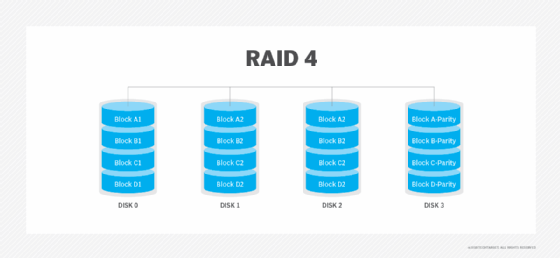RAID 4 (redundant array of independent disks)
What is RAID 4 (redundant array of independent disks)?
RAID 4 (redundant array of independent disks) is a RAID configuration that uses a dedicated parity disk and block-level striping across multiple disks.
Because data is striped in RAID 4, the records can be read from any disk. However, since all the writes must go to the dedicated parity disk, this causes a performance bottleneck for all write operations.
RAID 4 is not commonly used.

Similarities with other types of RAID
To improve random access performance, RAID 4 stripes data across many hard disk drives (HDDs), similar to RAID 3.
RAID 4 is also like RAID 5, but RAID 5 uses distributed parity. The dedicated parity HDD in RAID 4 also provides data protection.
Editor's note: This article was revised in 2023 by TechTarget editors to improve the reader experience.







